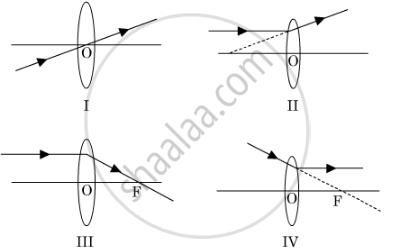Advertisements
Advertisements
प्रश्न
Describe the nature of image formed when an object is placed at a distance of 30 cm from a convex lens of focal length 15 cm.
उत्तर
Given:
u = -30 cm
(Since the object is placed on the left side of lens)
Focal length f = +15 cm
According to lens formula:
`1/v-1/u=1/f`
or `1/v=1/f+1/u`
=`1/15+(-1/30)`
or v=30 cm
Thus, the image is formed at a distance of 30 cm from the convex lens. The plus sign for image distance shows that the image is formed on the right side of the convex lens. Only real and inverted image is formed on the right side of a convex lens; therefore, the image is real and inverted.
APPEARS IN
संबंधित प्रश्न
A student has obtained a magnified image of a flame on a screen using a convex lens. To draw the corresponding ray diagram to show the image formation, which of the following two rays whose paths after refraction are shown, should he select ?

(A) I and II
(B) II and III
(C) III and IV
(D) I and III
Which of the following lenses would you prefer to use while reading small letters found in a dictionary?
Draw a labelled ray diagram to show how a ray of light is refracted when it passes:
from an optically denser medium into air.
What would be the diameter of the image of the flower on the film?
An image formed on a screen is three times the size of the object. The object and screen are 80 cm apart when the image is sharply focussed.
State which type of lens is used.

i. Which type of microscope has the arrangement of lenses shown in the adjoining figure?
ii. Label the figure correctly.
iii. Write the working of this microscope.
iv. Where does this microscope used?
v. Suggest a way to increase the efficiency of this microscope.
Yesh find out F1 and F2 of symmetric convex lens experimentally then which conclusion is true.
Draw a ray diagram to illustrate the determination of the focal length of a convex lens using an auxiliary plane mirror.
_______ is a combination of two convex lenses with small focal length.
Find the odd one out and give its explanation.
